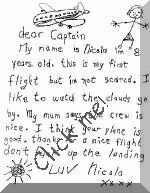
Welcome, from sunny Australia!
My Aviation Page - Some Pictures

My Aviation Page - Some Pictures
 |
 |
 |
 |
| Air Atlanta Icelandic do a lot of their ground maintenance at Mansten, on the east coast of the United Kingdom. It's an old World War Two military airport, and so it has plenty of room to park planes in odd corners. One of those corners is on the end of a long taxyway that cuts right across one of the the main roads to the south out of Margate. The taxyway is so narrow that we can't actually taxy under our own power, and so have to get towed for I guess about a kilometre to where we can start the engines. To get there, the airport staff have to take down part of the fence that surrounds the airport and block off the road traffic. Again, apologies for the poor quality of some of the pics but the windscreens were a little grubby on the right hand side. |



Back to the
first Aviation page
On to the
747 Pictures Page
On to
the More 747 Pictures Page
On to
the More 747 Pictures & Metro Page
More Aviation links can be found on my Links page.